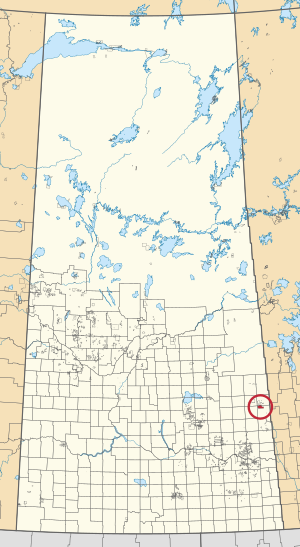Cote 64 facts for kids
Quick facts for kids
Cote 64
|
|
|---|---|
| Cote Indian Reserve No. 64 | |

Location in Saskatchewan
|
|
| First Nation | Cote |
| Country | Canada |
| Province | Saskatchewan |
| Area | |
| • Total | 8,088.2 ha (19,986.4 acre) |
| Population
(2016)
|
|
| • Total | 748 |
| Community Well-Being Index | 51 |
Cote 64 is a special area of land in Saskatchewan, Canada. It is known as an Indian reserve. This land belongs to the Cote First Nation. It is located about 16 kilometers (10 miles) west of the border with Manitoba.
In 2016, a count showed that 748 people lived in Cote 64. They lived in 220 homes. The community's well-being was also measured. This measurement is called the Community Well-Being Index. It helps us understand how well a community is doing. It looks at things like health, education, and jobs. In 2016, Cote 64 had a score of 51 out of 100. This score was compared to other communities. The average for other First Nations communities was 58.4. The average for non-Indigenous communities was 77.5.
Contents
What is an Indian Reserve?
An Indian reserve is a piece of land in Canada. It is set aside by the government for the use of First Nations people. These lands are for the exclusive use of a specific First Nation. They are protected under Canadian law. Reserves are important places for First Nations communities. They help keep their cultures and traditions alive.
How Reserves Were Created
Many reserves were created through treaties. Treaties are agreements between First Nations and the Canadian government. These agreements often involved First Nations sharing their traditional lands. In return, they received reserve lands and other benefits. The idea was to provide a secure home for First Nations.
Life on a Reserve
Life on a reserve can be different from other communities. First Nations governments manage many services. These include education, health, and housing. People on reserves work to build strong communities. They also work to preserve their unique heritage.
Who are the Cote First Nation?
The Cote First Nation is an Anishinaabe (Saulteaux) First Nation. They are part of the larger Anishinaabe group. Their traditional lands are in the prairies of Saskatchewan. The Cote First Nation has a rich history. They have lived in this area for a very long time.
Language and Culture
The people of Cote First Nation speak the Anishinaabemowin language. This language is also known as Ojibwe or Saulteaux. Language is a very important part of their culture. It helps pass down stories, traditions, and knowledge. The community works to teach their language to younger generations. They also celebrate their cultural practices. These include traditional ceremonies and gatherings.
Community and Governance
The Cote First Nation has its own government. This government is led by a chief and council. They make decisions for the community. They work to improve the lives of their people. They also manage the reserve lands and resources. The community works together on many projects. These projects help everyone in the First Nation.
Understanding Community Well-Being
The Community Well-Being Index is a tool. It helps measure how well communities are doing. It looks at several important areas. These areas include education, income, and housing. A higher score means a community is doing better in these areas.
Why This Index Matters
This index helps governments and communities. It shows where support might be needed. For example, a lower score might mean more resources are needed. These resources could be for schools or job training. The index helps plan for a better future. It aims to improve life for everyone.
Working Towards a Better Future
First Nations communities are working hard. They are improving their well-being. They are building new schools and health centers. They are also creating new job opportunities. The goal is to raise the Community Well-Being Index score. This means a better quality of life for all members.

